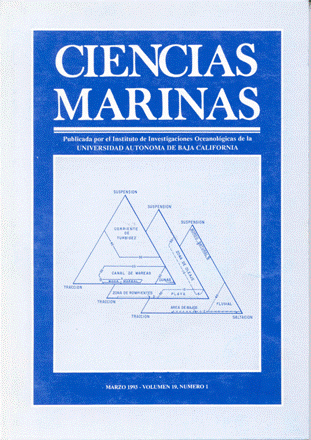Upwelling conditions associated to the distribution of zooplankton in San Hipolito, B.C.S.
Main Article Content
Abstract
From June 22 to 24, 1989, temperature, salinity, dissolved oxygen, nitrate, phosphate (0 to 300 m depth), wind speed and direction were measured in a grid of 35 hydrographic stations in the coastal Pacific off Bahía San Hipólito, B.C.S. Zooplankton biomass, abundance and diversity of the copepod community were also determined. The average wind direction and speed were 309º NW and 6.7 m s–1, respectively. The correlation coefficient between sigma-t and NO3–1 in the 25.0 to 26.0 density range was 0.67 (r, 95% confidence level). In general, high concentrations of zooplankton biomass were found at the coolest coastal stations. Thirty-three species of copepod were identified, dominated by Calanus pacifìcus (91%) and, in lesser abundance, by Pleuromama abdominalis (6.2%) and Calanus minor (0.7). A taxonomic analysis of the composition of copepods indicated a predominantly transitional fauna with some species of temperate-tropical origin. Using wind velocity and nitrate distribution, we estimate that 80 millimoles of NO3–1 m–2 d–1 are transported into the euphotic zone, which is equivalent to a new production of approximately 6.4 g C m–2 d–1. This value is considered high in comparison to other upwelling areas and apparently maintains high zooplankton biomass at inshore stations.
Downloads
Article Details
This is an open access article distributed under a Creative Commons Attribution 4.0 License, which allows you to share and adapt the work, as long as you give appropriate credit to the original author(s) and the source, provide a link to the Creative Commons license, and indicate if changes were made. Figures, tables and other elements in the article are included in the article’s CC BY 4.0 license, unless otherwise indicated. The journal title is protected by copyrights and not subject to this license. Full license deed can be viewed here.

